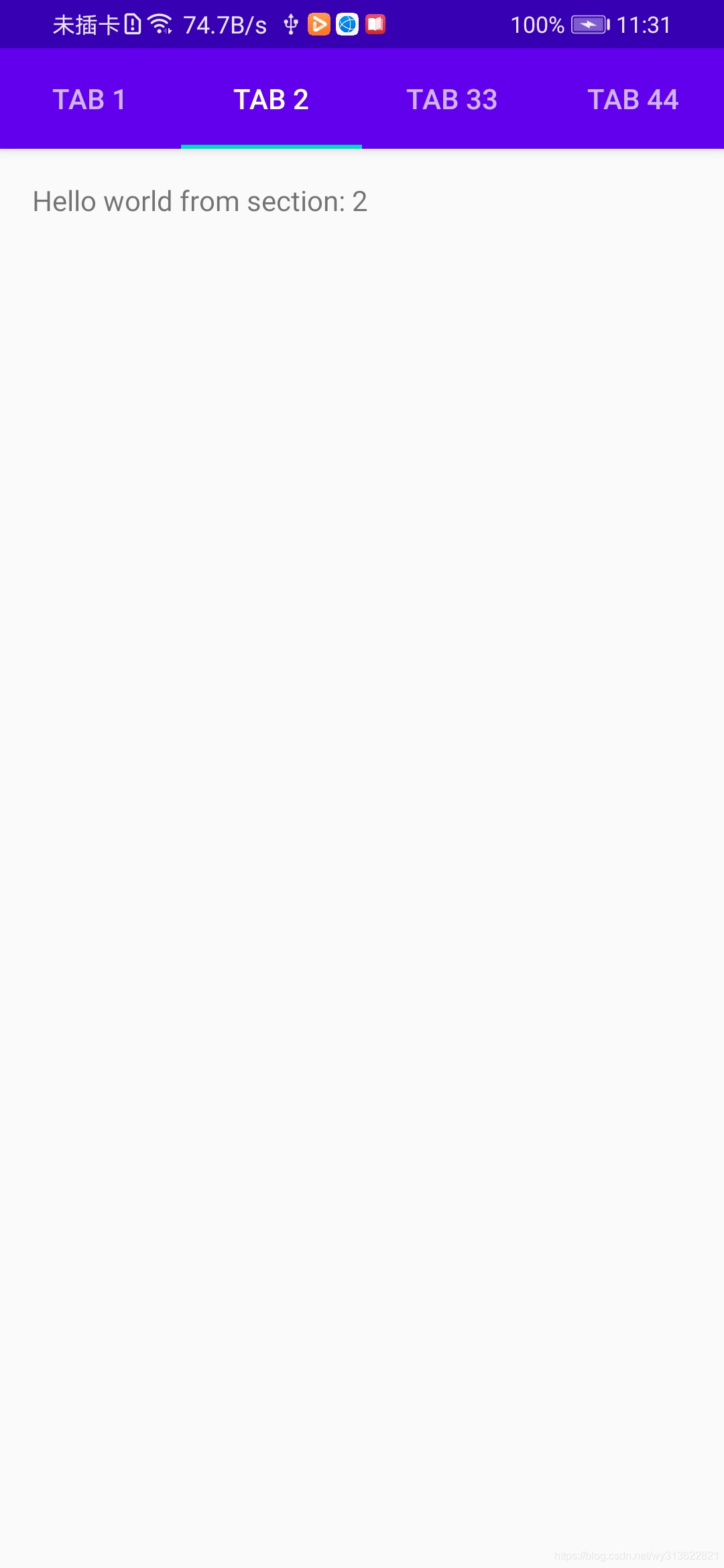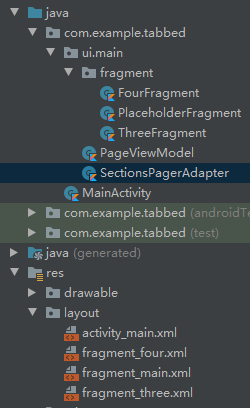简介
使用google原生推荐的TabLayout+viewpager,超级好用,而且性能上已经是优化到最好了,超级推荐大家这样用,代码的每个细节的作用和功能我都已经标明,下面来看看效果图:


代码
MainActivity
class MainActivity : AppCompatActivity() {
override fun onCreate(savedInstanceState: Bundle?) {
super.onCreate(savedInstanceState)
setContentView(R.layout.activity_main)
val sectionsPagerAdapter = SectionsPagerAdapter(this, supportFragmentManager)
val viewPager: ViewPager = findViewById(R.id.view_pager)
viewPager.adapter = sectionsPagerAdapter
val tabs: TabLayout = findViewById(R.id.tabs)
tabs.setupWithViewPager(viewPager)
}
}
SectionsPagerAdapter
class SectionsPagerAdapter(private val context: Context, fm: FragmentManager)
: FragmentPagerAdapter(fm) {
//顶部tablayout的字符
private val TAB_TITLES = arrayOf(
R.string.tab_text_1,
R.string.tab_text_2,
R.string.tab_text_3,
R.string.tab_text_4
)
override fun getItem(position: Int): Fragment {
// 顶部有多少个tab,就会运行多少次(初次会加载第一第二,第三第四要点第三个tab才会运行)
/*******新建Fragment******/
Log.d("WY+","运行第几次:"+(position+1))
when (position) {
0 -> {
return PlaceholderFragment.newInstance(position + 1)
}
1 -> {
return PlaceholderFragment.newInstance(position + 1)
}
2 -> {
return ThreeFragment.newInstance(0)
}
3 -> {
return FourFragment.newInstance(0)
}
}
return PlaceholderFragment.newInstance(position + 1)
}
override fun getPageTitle(position: Int): CharSequence? {
return context.resources.getString(TAB_TITLES[position])
}
override fun getCount(): Int {
// 顶部显示多少个页,不要超过TAB_TITLES的总数.
return 4
}
}
PageViewModel
class PageViewModel : ViewModel() {
private val _index = MutableLiveData<Int>()
val text: LiveData<String> = Transformations.map(_index) {
"Hello world from section: $it"
}
fun setIndex(index: Int) {
_index.value = index
}
}
ThreeFragment
class ThreeFragment : Fragment() {
override fun onCreateView(
inflater: LayoutInflater, container: ViewGroup?,
savedInstanceState: Bundle?
): View? {
val root = inflater.inflate(R.layout.fragment_three, container, false)
return root
}
companion object {
/**
* 单例,返回给定节编号的此片段的新实例。
*/
@JvmStatic
fun newInstance(sectionNumber: Int): ThreeFragment {
return ThreeFragment().apply {
}
}
}
}
PlaceholderFragment
class PlaceholderFragment : Fragment() {
private lateinit var pageViewModel: PageViewModel
override fun onCreate(savedInstanceState: Bundle?) {
super.onCreate(savedInstanceState)
// 实例一个PageViewModel,object.apply返回一个自身的对象(object),apply可以赋值一个类里面的属性和调用方法
pageViewModel = ViewModelProviders.of(this).get(PageViewModel::class.java).apply {
setIndex(arguments?.getInt(ARG_SECTION_NUMBER) ?: 1)
}
}
override fun onCreateView(
inflater: LayoutInflater, container: ViewGroup?,
savedInstanceState: Bundle?
): View? {
val root = inflater.inflate(R.layout.fragment_main, container, false)
val textView: TextView = root.findViewById(R.id.section_label)
pageViewModel.text.observe(viewLifecycleOwner, Observer<String> {
Log.d("WY+", "===>$it")
textView.text = it
})
return root
}
companion object {
private const val ARG_SECTION_NUMBER = "section_number"
/**
* 返回给定节编号的此片段的新实例。
*/
@JvmStatic
fun newInstance(sectionNumber: Int): PlaceholderFragment {
return PlaceholderFragment().apply {
arguments = Bundle().apply {
putInt(ARG_SECTION_NUMBER, sectionNumber)
}
}
}
}
}
FourFragment
class FourFragment : Fragment() {
override fun onCreateView(
inflater: LayoutInflater, container: ViewGroup?,
savedInstanceState: Bundle?
): View? {
val root = inflater.inflate(R.layout.fragment_four, container, false)
return root
}
companion object {
/**
* 单例,返回给定节编号的此片段的新实例。
*/
@JvmStatic
fun newInstance(sectionNumber: Int): ThreeFragment {
return ThreeFragment().apply {
}
}
}
}
activity_main.xml
<?xml version="1.0" encoding="utf-8"?>
<androidx.constraintlayout.widget.ConstraintLayout xmlns:android="http://schemas.android.com/apk/res/android"
xmlns:app="http://schemas.android.com/apk/res-auto"
xmlns:tools="http://schemas.android.com/tools"
android:layout_width="match_parent"
android:layout_height="match_parent"
tools:context=".MainActivity">
<com.google.android.material.appbar.AppBarLayout
android:layout_width="match_parent"
android:layout_height="wrap_content"
app:layout_constraintTop_toTopOf="parent"
android:theme="@style/AppTheme.AppBarOverlay">
<com.google.android.material.tabs.TabLayout
android:id="@+id/tabs"
android:layout_width="match_parent"
android:layout_height="50dp"
android:background="?attr/colorPrimary" />
</com.google.android.material.appbar.AppBarLayout>
<androidx.viewpager.widget.ViewPager
android:id="@+id/view_pager"
android:layout_width="match_parent"
android:layout_height="match_parent"
app:layout_behavior="@string/appbar_scrolling_view_behavior" />
</androidx.constraintlayout.widget.ConstraintLayout>
fragment_main.xml
<?xml version="1.0" encoding="utf-8"?>
<androidx.constraintlayout.widget.ConstraintLayout xmlns:android="http://schemas.android.com/apk/res/android"
xmlns:app="http://schemas.android.com/apk/res-auto"
xmlns:tools="http://schemas.android.com/tools"
android:id="@+id/constraintLayout"
android:layout_width="match_parent"
android:layout_height="match_parent"
tools:context=".ui.main.fragment.PlaceholderFragment">
<TextView
android:id="@+id/section_label"
android:layout_width="wrap_content"
android:layout_height="wrap_content"
android:layout_marginStart="@dimen/activity_horizontal_margin"
android:layout_marginTop="@dimen/activity_vertical_margin"
android:layout_marginEnd="@dimen/activity_horizontal_margin"
android:layout_marginBottom="@dimen/activity_vertical_margin"
app:layout_constraintLeft_toLeftOf="parent"
app:layout_constraintTop_toTopOf="@+id/constraintLayout"
tools:layout_constraintLeft_creator="1"
tools:layout_constraintTop_creator="1" />
</androidx.constraintlayout.widget.ConstraintLayout>
fragment_three.xml
<?xml version="1.0" encoding="utf-8"?>
<androidx.constraintlayout.widget.ConstraintLayout xmlns:android="http://schemas.android.com/apk/res/android"
xmlns:app="http://schemas.android.com/apk/res-auto"
xmlns:tools="http://schemas.android.com/tools"
android:id="@+id/constraintLayout"
android:layout_width="match_parent"
android:layout_height="match_parent"
tools:context=".ui.main.fragment.PlaceholderFragment">
<TextView
android:id="@+id/section_label"
android:layout_width="wrap_content"
android:layout_height="wrap_content"
app:layout_constraintLeft_toLeftOf="parent"
app:layout_constraintTop_toTopOf="@+id/constraintLayout"
android:text="独立的fragment3" />
</androidx.constraintlayout.widget.ConstraintLayout>
fragment_four.xml
<?xml version="1.0" encoding="utf-8"?>
<androidx.constraintlayout.widget.ConstraintLayout xmlns:android="http://schemas.android.com/apk/res/android"
xmlns:app="http://schemas.android.com/apk/res-auto"
xmlns:tools="http://schemas.android.com/tools"
android:id="@+id/constraintLayout"
android:layout_width="match_parent"
android:layout_height="match_parent"
tools:context=".ui.main.fragment.PlaceholderFragment">
<TextView
android:id="@+id/section_label"
android:layout_width="wrap_content"
android:layout_height="wrap_content"
app:layout_constraintLeft_toLeftOf="parent"
app:layout_constraintTop_toTopOf="@+id/constraintLayout"
android:text="2222" />
</androidx.constraintlayout.widget.ConstraintLayout>
最后想要demo的朋友可到这里下载:https://download.csdn.net/download/wy313622821/12520093
注意:谷歌原生的代码布局是使用CoordinatorLayout,在配合底部导航栏使用时,切换其他的页面时会产生一个空白的区域,解决这个问题就是把CoordinatorLayout换成ConstraintLayout